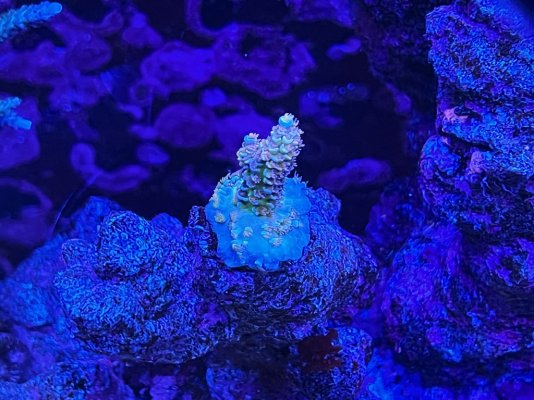An ICP-OES test would be great to make sure none of your trace minerals are off or your messing with something like Tin from a worn out dosing line.So I'm considering tapping out on the phosphates and considering using TM Elimi Phos as @ScottB had suggested at one point.
I had one millie frag RTN last month. This particular frag had been puttering along since I dipped all the corals all summer and I didn't make too much of it.
Then this week my acrolandia tenuis which had been growing very well (and my favorite tenuis) RTN'd out of no where . Most of the corals in the system look really good with good growth and polyp extension. In general, the tank looks good, but two months ago everything looked really good. Now, there are some pieces that looks less happy.
I removed the dying sponge to remove that as a variable. The alkalinity has been very stable around 7.8. In the past 3 months it has never been below 7.6 or above 8.2 and I've adjusted the kalk dosing to flatten the alkalinity curve. Temperature has been 76-78 consistently. pH has been stable and currently is 8.1 to 8.4. I calibrated the probe in mid September and then again last night. Calcium is up to 460. Mg is 1340. That's a long way of saying, I think all the other usual parameter have been stable and in a good range.
I sent a new ICP test this morning and await results. I checked phosphates today and measured 0.9 on the Hanna. That is likely elevated above the true level a little because I had already started feeding for the day. I'll recheck in the morning but believe the true value of phosphates are likely around 0.7 to 0.8. So I'd like to bring it down to below 0.5 in the short term and down to 0.1 to 0.2 in the long term. Although, I'm not clear that things are less happy due to the elevated phosphates, I also don't believe those levels are helping anything. Nitrates are 0.25 to 0.4 on the Nyos test kit.
Nothing is crashing, There's no emergency. It's possible I'm just upset I lost of one of my favorite acros, but I've decided it would be best to correct course a bit. So where should I start?
Here's what I have to play with:
I plan to go slow and lower phosphates by no more than 0.1 in a day or 0.2- 0.3 in a week. I was thinking starting with a couple 10% water changes. Adding a small amount of rowa phos to the reactor since I have it on hand. I will receive the elimiphos in a couple days and will plan to dose it to the overflow. I'll need to calculate the dosage, but the actual volume of water in my system accounting for displacement is about 250 gallons.
- 100 gallons of fresh salt water on hand.
- rowa phos on hand, and an available reactor
- I have ordered TM elimiphos, lanthanum chloride
- *The fuge is maxed out in terms of the amount of chaeto and the photoperiod is at 16 hours. When I went up to 18 hours, I thought chaeto growth slowed which was counterproductive
I appreciate any input.
I would only choose ONE method of reducing PO4 at a time... your system is running so well and you have all the right knowledge. Take it slow and don't rush by taking a multi-pronged attack; you'll end up throwing things way out of wack. Also, make sure you're monitoring your nitrates with your PO4. Depending on the method of reduction you use, it may have a proportional effect on reducing nitrate. I would probably start with lanthanum chloride.




















